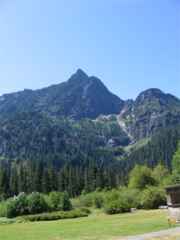SEEKING THE ICE
on December 15, 2005,
as I sit and shiver in 20 degree temperatures
I recall with fondness, a hot day in August
when son and grandchildren took me to the
Big Four Ice Caves northeast of Everett
|
|
We parked in a forest service parking lot, free with my Golden Age Pass. It was a fine morning for a hike. Fortified with snacks and water, we proceeded to the trailhead toward glaciers that had turned into caves of ice. In the mountain the stream feeding the valley was visible from the parking lot. Our trail did not come near it. |
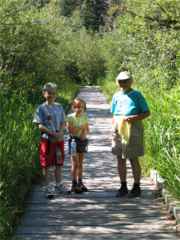 |
This was a normal August morning and a bit too warm for a hard walk. We had a boardwalk across the first part of the trail that was a marsh and would not have very much fun to hike otherwise. All of us were ready to begin the ascent toward the glaciers looking forward to a cooler altitude. |
 |
Plants are sturdy and tenacious at this altitude and in August we were treated to lovely flowers. Other plants had seeds and several species yielded berries for late summer snacking, usually by bear although we saw none of that critter. |
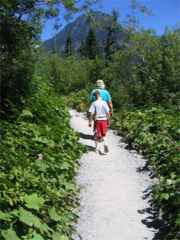 |
A long part of the trail was tarmack where the slope was less than three percent - making it easily wheelchair accessible. One family managed nicely. Pushing the wheelchair with its teen passenger was no piece of cake. Walking for me was not difficult, still it was more stressful than the level path. |
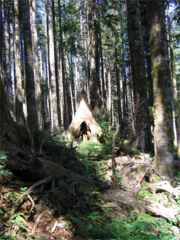 |
The easy trail did not go the entire distance through the forested area. The shade was pleasant and the thick wooded area was rampant with fallen trees that made unusual and unexpected visions. What appeared to be a tipi was just a bleached overturned tree root system. |
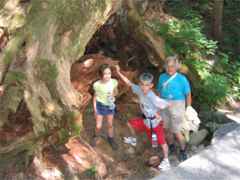 |
An ancient tree with a hollow base provided welcome rest along the steepest part of the trail. It died a natural death many years ago to become a dandy photo opportunity, especially for hams that loved to look into a camera. |
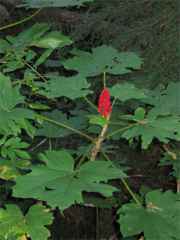 |
The red flower looked out of place among these leaves but a delightful focus in the shady area. The plant was tall, growing well below the trail reaching up toward the sun light. Plants never cease to amaze me becoming even more wonderful when I reflect on their ability to make leaves out of light, water and soil. |
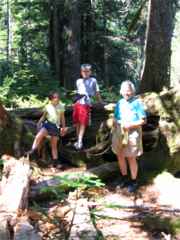 |
One last rest before the final climb on a rocky excuse for a trail. Good thing we were primed to see the glaciers which were melting at an alarming rate the past years while Washington state experienced very little rain and so little snowfall that ski areas had no skiing season to speak of. |
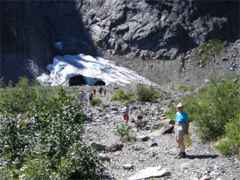 |
Then the glacier was visible. It looked like a small bank of ice to me but it also appeared to be a very long distance away considering the size of the people that were hardly more than specks beside it. |
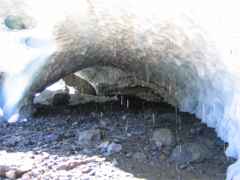 |
Exploring people still looked small as we came closer. The phenomenon of a glacier melting from the inside is an anomaly to my way of thinking. But the laws of nature often come up with deviations of what I think is normal. |
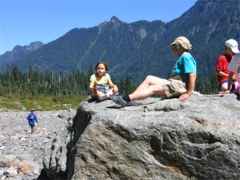 |
Morgan and I climbed on to a huge boulder to eat our snacks. We were still a great many yards away from the cave which the Park Ranger suggested we not go into. He seen only a few accidents and wanted no more. |
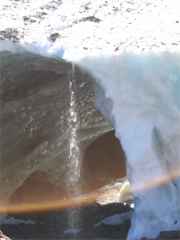 |
My new Hunydai was a color called Glacier blue and I didn't believe it was a very good call until I saw this. I don't see colors very clearly but people who had cataracts removed said they attained a whole new color vision. Looks like I have a treat in store for me come my operation in January. |
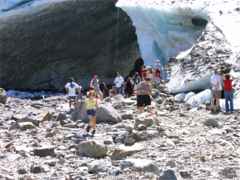 |
There was a smaller glacier across the rocky moon scape and Avery and Morgan were eager to get to it. It was far across the moraine but we were determined to get close up expecting it to disappear before another year passed. |
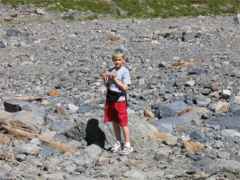 |
Several thousand yards of interesting rocks took every kid's attention and Avery was no exception. Not only the color of minerals was eye catching but the shapes were quite interesting as well. |
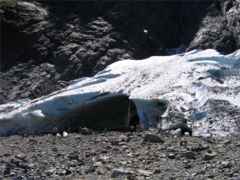 |
This glacier was indeed smaller than the first we saw and was no longer melting with the same intensity from the interior. It appeared to simply be settling into the porous soil on which it rested. |
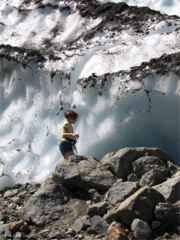 |
Morgan was as fascinated by the melting ice as she was by the curious rock colors. She would disappear below the large rocks and worry me until she popped up again when she gained footing on the next one. Not necessarily more sure footed than I, her hands became the two extra feet to move along safely. |
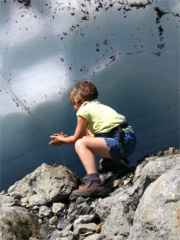 |
Sometimes I used the four footed stance to move up the rocky moraine. Since the trail down to our car was a long way across, I decided to begin scooting in that direction instead. Morgan had to wash off her rocks before she left. Water enhanced the colors better than her spit. |
 |
Looking back toward the mountain side of uplifted shale I was reminded of the violence the earth's surface undergoes as the earth turns in its orbit. Present action appears most visible around the Middle east and India. |
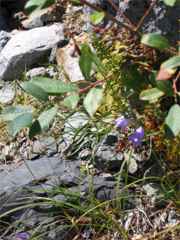 |
Viola-like flowers struggle in the rocks by the trail as we begin to backtrack down the mountain. Somehow the way back seemed to be shorter. At least we have gravity to help us descend. My knee threatened to remind me I was carrying too much weight when I stomped too hard down the steepest parts. |
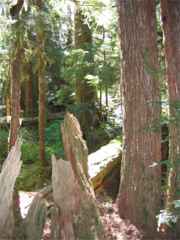 |
Trees are amazing plants in any habitat but they struggle more on mountain sides. Here they had to contend with lightning strikes as well as the huge variation of temperatures from one season to the next. Not to mention insects that favored settling into bark and leaves. |
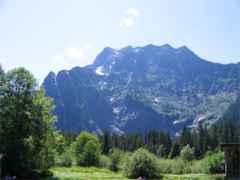 |
So here we were again in the parking lot to view the Big Four Peak for which the ice caves were named. Relatively easy to reach by the large population of the Puget Sound area, the caves receive thousands of visitors each year. |
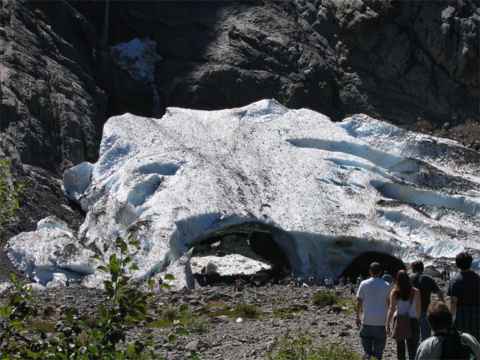
The sun is shining on the moraine from above and behind the glacier.
Thomas and Avery visited these glaciers for the past four years and were appalled
at the reduced area they found this year. At the present rate of thawing
with no more increase of ice buildup than had occurred in that time, Thomas
predicted that it would disappear before the fall of 2006
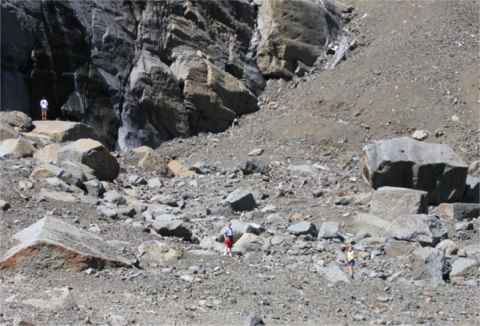
A flat photograph cannot show the depth and distance across this rocky area.
It was difficult to keep track of the children and each other among the rocks.
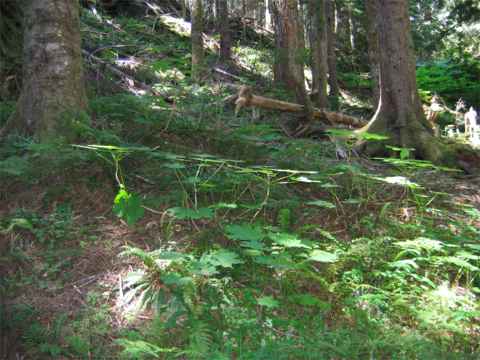
The trees were too tall to allow much bird watching without binoculars.
There were many nosy insects that prevented my dallying anyway.
Copyright
The Sherer Group
1997-2005
